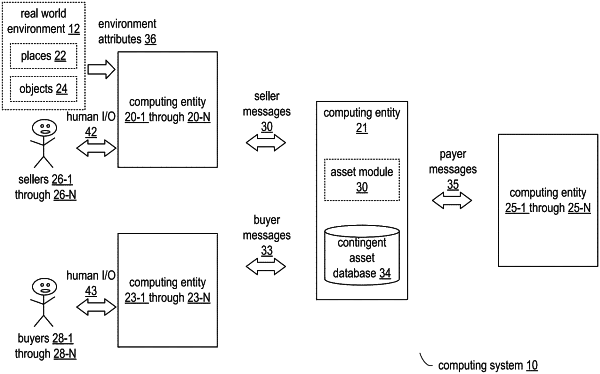| CPC G06Q 20/4016 (2013.01) [G06Q 20/123 (2013.01); G06Q 30/0619 (2013.01); H04L 9/3247 (2013.01); H04L 9/50 (2022.05); G06Q 2220/00 (2013.01); H04L 2209/56 (2013.01)] | 4 Claims |

|
1. A computer-implemented method of using a computing infrastructure for utilizing an object distributed ledger, the method comprising:
issuing, by an object owner computing entity of the computing infrastructure to a marketplace computing entity of the computing infrastructure, one or more of digital records of a set of contingent assets, the one or more of digital records comprising an asset identifier, a lifecycle status indictor, a potential payer liability value, a payer identifier, and a seller identifier of at least one contingent asset of the set of contingent assets, and at least one owner identifier associated with the set of contingent assets;
identifying, by the marketplace computing entity, an asset authenticity computing entity of the computing infrastructure based on at least one of the asset identifier, payer identifier, and the seller identifier of the at least one contingent asset of the set of contingent assets;
generating, by the asset authenticity computing entity, authenticity information utilizing the at least one of the asset identifier, the payer identifier, and the seller identifier of the at least one contingent asset of the set of contingent assets from the marketplace computing entity;
interpreting, by the marketplace computing entity, the authenticity information from the asset authenticity computing entity to produce an authenticity indicator associated with the at least one contingent asset, the authenticity indicator comprising one of an approved status, a pending status, and a disapproved status;
determining, by the marketplace computing entity, that the authenticity indicator of the at least one contingent asset is the same as the lifecycle status indictor;
generating, by the marketplace computing entity, a smart contract to indicate availability of the at least one contingent asset to include available terms and the authenticity indicator;
obtaining, by the marketplace computing entity, a copy of the object distributed ledger;
hashing, by the marketplace computing entity, the smart contract utilizing a receiving public key of the object distributed ledger to produce a next transaction hash value;
encrypting, by the marketplace computing entity, the next transaction hash value utilizing a private key of the marketplace computing entity to produce a next transaction signature;
generating, by the marketplace computing entity, a next block of a blockchain of the object distributed ledger to include the smart contract and the next transaction signature; and
causing, by the marketplace computing entity, inclusion of the next block in the object distributed ledger.
|